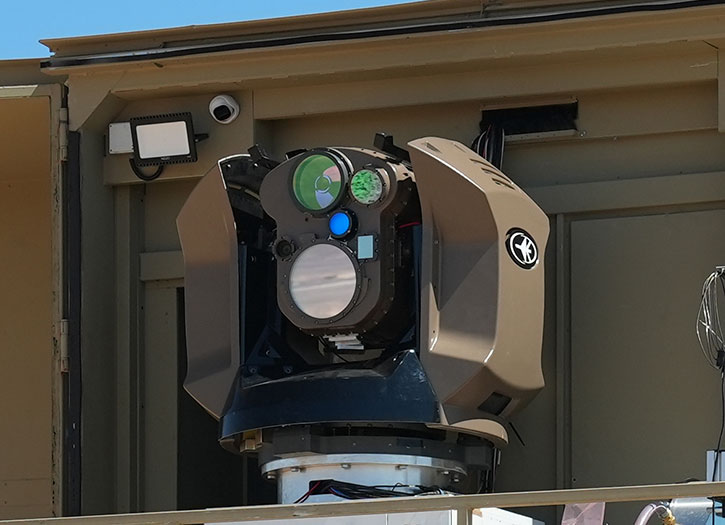Updated: April 14, 2022: Israel’s Minister of Defense Benny Gantz has approved allocating a significant budget to develop and produce a high-power solid-state laser system designed to intercept rockets, mortars, and UAVs. Rafael, the system developer, expects to sign the full-scale development contract with the Ministry of Defense in the coming days; the initial investment amounts to hundreds of millions of NIS. By mid-April 2022, the technology demonstrator completed the first test series, intercepting UAVs, mortars, rockets, and anti-tank missiles in various scenarios.

The system’s production and deployment will cost hundreds of millions of NIS more, and the funding approved will cover the system development, procurement, and initial deployment. As Iron Beam becomes operational, it will be integrated into Israel’s multi-tier air and missile defense system, providing a cost-effective and operationally efficient lower-tier defense against missiles, unmanned aerial vehicles, rockets, and mortars.
According to Rafael’s CEO, Maj. Gen. (Res.) Yoav Har-Even, “the ‘Iron-Beam’ system, is the most powerful laser system of its kind in the world.” Rafael first introduced the Iron Beam high-energy laser technology concept in 2014, depicting a system consisting of a pair of high-energy lasers effectors. The two systems would deliver a combined effect with the power level required and dwell time necessary to defeat rocket and missile type airborne targets.


The ministerial decision was announced by Minister of Defense Benny Gantz at Rafael compound, together with the head of Research and Development at the DDR&D Brigadier General Yaniv Rotem, where CEO of Rafael, Maj. Gen. (Res.) Yoav Har-Even, and General Manager at Elbit Systems ISTAR & EW, Oren Sabag, presented the prototype. Subsequently, the Minister of Defense approved the plan’s progression according to the work plan and the agreement with Rafael.

The funding approval follows the program’s feasibility demonstration conducted by Israel’s Ministry of Defense (IMOD) Directorate of Defense R&D (DDR&D), which demonstrated the technological breakthrough in the development of the “Iron Beam” high-power laser system. DDR&D will be the program manager, with prime contractor Rafael and subcontractor Elbit Systems. Both companies have already demonstrated proof-of-concept land-based (Rafael) and airborne (Elbit Systems) high-power laser systems.

“Today we are advancing towards a dramatic change in the battlefield and enhancing Israel’s security in the face of growing threats emanating from Gaza, Lebanon, and Syria, supported by Iran and terrorist organizations.” Minister of Defense Benny Gantz said, “The high-power laser system constitutes a strategic change in Israel’s defense of the home front in addition to the political and operational echelons’ flexibility during combat. As in the past, the DDR&D, Israeli industries, and the defense establishment continue to maintain Israel’s operational edge and save lives through creativity, flexibility, and ground-breaking technologies. We will do everything we can and allocate the necessary resources to complete the process as quickly as possible, and I am sure that along with the unprecedented operational and security gain, our investment will also lead to great economic gain for the State of Israel and ground-breaking collaborations with our allies.” Ganz added.

Israel’s investments in laser technology have led to the ability to precisely focus laser beams on long-range targets, overcoming atmospheric disturbances. The new technology is critical for the delivery of laser effects on target within a short time. It will enable the development of laser weapons capable of intercepting various threats. IMOD embarked on three parallel high-energy laser weapon systems demonstrator programs with Elbit Systems and Rafael based on that technology demonstration. In a recent test, Elbit Systems has already demonstrated the feasibility of such a laser to defeat airborne targets.
Israel’s ground-based laser weapon system is developed as a containerized system that will field similar to the Iron Dome launchers. It will complement the capabilities of the Iron Dome, establishing the lowest tier layer to augment Israel’s four-layered air defense system. This lowest layer will be able to defeat mortar bombs, and short-range rockets fired at very short ranges, leaving a very short time for intercept. While the Iron Dome missile-based C-RAM has demonstrated the capability to engage those threats, their interception by missiles is too costly to deliver for an optimal response.
DDR&D also develops a compact laser system mounted on vehicles to protect maneuver forces against direct and indirect threats. These lasers will complement the vehicle-specific active protection systems deployed on heavy and future armored combat vehicles, such as the Merkava and Namer, and provide a higher level of protection for less protected vehicles or troops in the open.




















